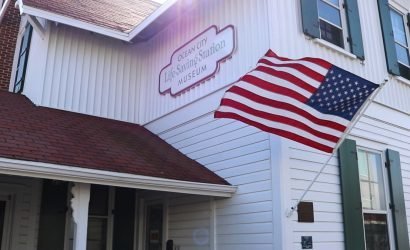An intricately hand-painted canvas throw carpet fits perfectly in the entry way of the Calvin B. Taylor House. The walls are also covered with intricate grey and black wallpaper. The molding has a faux, hand-painted marble print that covers the base of each plaster wall. The large and heavy wooden doors are covered in a deep reddish brown painted wood grain print. Overhead a big, heavy metal chandelier hangs perfectly still. In the corner, a small Christmas tree is nestled, barely noticeable next to all of the patterns, prints, and design elements characteristic to the early 1800’s.
In 1832, everything was intricate; the Calvin B. Taylor House in Berlin (208 N. Main Street) proves this. Practically every surface of the federal house is covered in rich details. The home, located in Berlin’s National Register Historical District and listed as a historic building in the Maryland Historical Trust documents, has been furnished as a house and museum that is often open for tours.
The house features a gable façade covered with beaded clapboard that is built on a brick foundation. The entrance is shadowed by a second-story Palladian style window with corner blocks and a stained glass sash. The rest of the windows are simple; basic trim and single sash. Elliptical carvings and irregular sunbursts are hidden on the columns that line the front Doric portico. During the holiday season, the bright green front door on the Taylor house also dons a fresh evergreen wreath with a big red bow.
Last weekend, the Taylor House Museum was open for free tours. Several knowledgeable tour guides were on location to walk guests through the home, speak about the house's history, and discuss history in relation to Berlin, MD. Guests could also admire the holiday decorations nicely placed, just like in the early 1800’s, around the property.
Freshly cut greens from the property were strung together to create flowing garlands and draped over the two mantles on the first floor. Floral arrangements that included white pine and holly branches were placed on the antique desk in the study as well as the decorative tables in the formal living room. Dark green swags were laid down the center of the mahogany dining table that seats six. Pine cones and a bright mustard yellow flowers were used as accents in each arrangement.
The home was originally built for Isaac Covington and his family. The Covington’s lived in the home during the Civil War. They were a wealthy family who owned many plantations in the Snow Hill area and traded goods in the West Indies. As estate inventory suggests, it is believed that Mr. Covington owned a local store.
After the Covington’s, the house was occupied by many other Berlin businessmen. Robert J. Henry owned a farm near today’s Stephen Decatur Park and treated the large home as a town house. Henry was instrumental in bringing the railroad to Berlin and opened his home up to his loyal workers. In name sake, the Taylor family also lived in the white home. Calvin B. Taylor was a teacher, lawyer, and founder of the Taylor Banking Company, a local bank that was founded in 1890 and is still in operation today. Taylor and his wife, Mattie, renovated the home to fit their familial needs.
After remaining unoccupied for several years, seeing many owners come and go, being transformed into an apartment building in the ‘70’s, and scheduled to become a parking lot in the ‘80’s, the home was rescued by The Berlin Heritage Foundation. In November of 1981, Worcester County citizens convinced Town Council and the Mayor to purchase the home. The community graciously raised tens-of-thousands of dollars to bring the house back to life. The museum portion, the Taylor’s addition to the back side of the home, opened in 1983. Currently, The Calvin B. Taylor House Museum is administered by the Berlin Heritage Foundation.
Christmas skipped the Taylor House for several years simply because no one occupied the home. After the historic past of the house was traced, the Berlin Heritage Foundation decided to include the building in the annual Berlin Victorian Christmas activities. During Victorian Christmas, several historic buildings, businesses, and galleries open their doors to the public in honor of the holiday. The Taylor House Museum displays glimpses of the past: turn of the century furniture, house-hold items, old store contents, wardrobes, photos, and more. During the Christmas season, the Taylor House is decorated as if it were the Victorian Era.
The Victorian era of history was represented by Queen Victoria’s reign over Britain from 1837 to 1901. The Victorian era was marked by romanticism, mysticism, changing social values, and an increase of peace, prosperity, and art. Every holiday season, bits and pieces of this long-gone era can been seen in downtown Berlin, MD during Victorian Christmas. Berlin was alive and thriving during the Victorian Era in the United States.
Traditional Victorian Christmas décor includes strung garlands, gingerbread men and marzipan candies as decorations, fresh cookies, pine cones and berry bunches on display, along with the scent of pine, fir, and hemlock wafting through the air. Simply decorated Christmas trees were placed next to glowing fires and lit by small, slim candles placed carefully on large branches. Historic buildings like the Taylor House, the Atlantic Hotel, and the Merry Sherwood Plantation are currently decorated with respect to the Victorian traditions.
From November 25th to January 1st, the Atlantic Hotel will be open for tours in honor of Victorian Christmas. Only unoccupied rooms will be open based on hotel vacancy. The Merry Sherwood Plantation will host an open house, just like the Taylor House did last weekend, on December 15th from 4 – 8 pm. Both the Atlantic and Merry Sherwood will be decorated in Victorian-inspired holiday cheer.
Donations are accepted at the museum. All donations are used for the upkeep of the Taylor property. For more information, visit the Calvin B. Taylor House Museum website.









